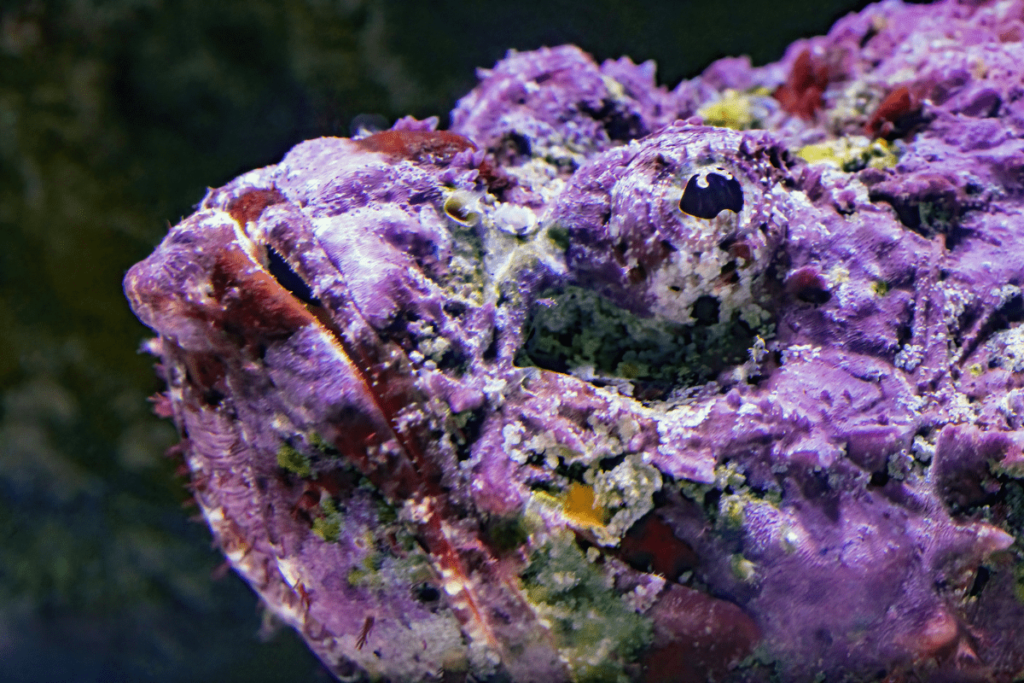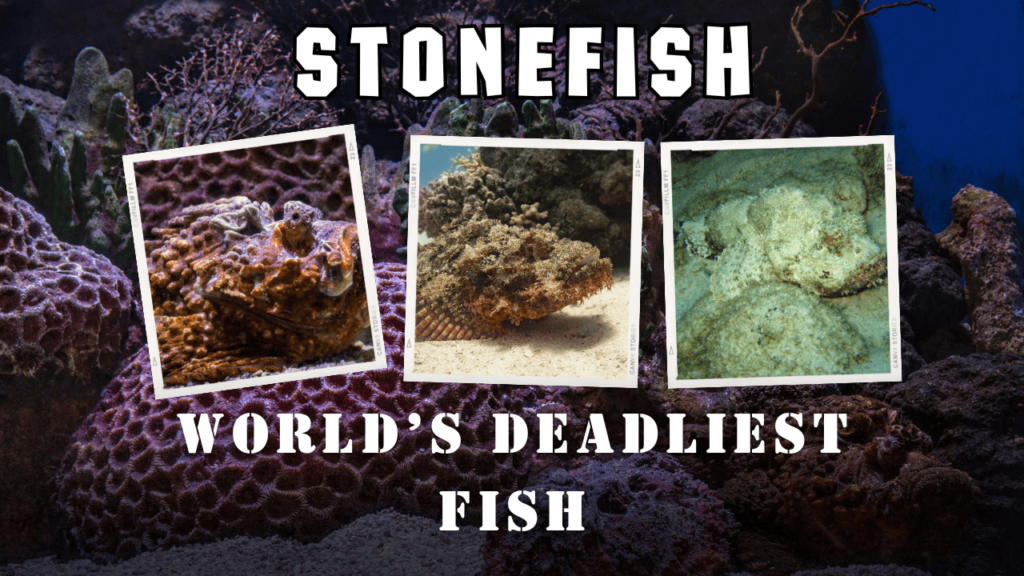The Stonefish, often dubbed as one of the most dangerous fish in the world, holds a fearsome reputation in the marine realm. With its venomous spines and remarkable camouflage, this fish is both intriguing and perilous. Imagine a creature so well-hidden that it can blend perfectly with its surroundings, yet possesses the most painful venom known to man. The Stonefish is not just a marvel of nature but also a testament to the hazards lurking beneath the ocean’s surface.
So, what is a Stonefish?
This remarkable fish is renowned for its deadly arsenal of venomous spines and its extraordinary ability to blend into its environment. The Stonefish’s camouflage is so effective that it often goes unnoticed until it’s too late. Its venomous spines, or Stonefish needles, are a critical adaptation that can deliver a sting causing excruciating pain and, in severe cases, can be fatal if not treated immediately.

In exploring what is a Stonefish, you’ll uncover a creature that embodies both the marvels and the perils of marine evolution. This article delves into ten shocking facts about the Stonefish that reveal why it is often referred to as the world’s deadliest fish. From its astonishing camouflage and venomous defenses to its ancient lineage and habitat preferences, each fact highlights the Stonefish’s unique role in the marine ecosystem.
Understanding these aspects is not only intriguing but crucial for anyone who ventures into its habitat. Whether you’re a marine enthusiast, a diver, or just a curious reader, these insights into the Stonefish will shed light on why this fish commands both respect and caution.
Animal Information for the Stonefish:
| Common Name | Stonefish |
| Scientific Name | Synanceia spp. |
| Family Name | Synanceiidae |
| Type | Fish |
| Size | 30-40 cm (12-16 in) in length |
| Weight | Up to 2 kg (4.4 lbs) |
| Size Relative to a 6-Ft Human | Comparable to a large dog |
| Diet | Small fish, invertebrates |
| Average Lifespan in the Wild | 5-10 years |
| Habitat | Coral reefs, sandy bottoms |
| Group Name | School |
| Found In | Indo-Pacific region |
| Conservation Status | Not Endangered |
10 Shocking Facts About Stonefish:
1. Master of Disguise
Fact: Stonefish are experts in camouflage, making them nearly invisible in their natural habitat.
Details: So, what is a Stonefish? This fish is renowned for its incredible ability to blend into its surroundings. Its body is covered with warty, irregular textures that mimic the look of coral reefs and sandy sea bottoms.
This camouflage allows the Stonefish to avoid predators and ambush prey with remarkable efficiency. The Stonefish’s ability to stay hidden while waiting for prey to come close is a key factor in its survival strategy.
Stonefish are of the Top 10 Camouflage Animals That Are Masters of Disguise in the Animal Kingdom. Check out which other animals made the list.
2. Venomous Spines
Fact: Stonefish have venomous spines along their dorsal fin that can deliver a painful sting.
Details: Stonefish venom is highly toxic and can cause extreme pain and even death if not treated immediately. One of the most dangerous aspects of the Stonefish is its venomous spines, or Stonefish needles, located on its dorsal fin. These spines contain toxins that can cause intense pain, swelling, and even serious health issues if not treated promptly.
The venom serves as a powerful defense mechanism, deterring predators and warning humans to steer clear. Immediate medical attention is crucial if stung by a Stonefish to manage the effects of its venom.
3. Deadly Sting
Fact: A Stonefish sting can be excruciatingly painful and potentially life-threatening.
Details: Stonefish spines are found along the fish’s back and are used for defense against predators. A Stonefish sting can cause intense pain that radiates from the site of the injury, accompanied by swelling, redness, and nausea. The pain from a Stonefish sting is often described as one of the most severe of any fish venom, with symptoms that can escalate quickly if not treated. A Stonefish needle can pierce through the skin and inject venom, causing severe pain.
In severe cases, the venom can lead to systemic reactions such as difficulty breathing and shock. Immediate medical attention is vital to manage the sting effectively. Antivenom and pain relief are commonly used treatments, making prompt action essential for anyone stung by this formidable fish.
4. Unique Feeding Habits
Fact: Stonefish are ambush predators with a unique hunting strategy.
Details: Stonefish employ a fascinating feeding strategy. They lie in wait, completely camouflaged, until unsuspecting prey comes close. Their ability to remain motionless while blending into the surroundings allows them to launch a surprise attack. When prey is within reach, the Stonefish opens its mouth rapidly to create a powerful suction that pulls the prey in.
Their diet primarily consists of smaller fish and invertebrates. The Stonefish’s ambush technique ensures that it can efficiently capture prey with minimal effort, making it a highly effective hunter. This method of feeding, combined with their camouflage, makes the Stonefish a formidable predator in its marine environment.

5. Ancient Creatures
Fact: Stonefish have been around for millions of years, making them ancient survivors.
Details: It’s fascinating to note that these creatures have a long evolutionary history. Stonefish have existed for approximately 40 million years, evolving very little over this vast period. Their ancient lineage means they have survived numerous changes in the Earth’s climate and marine environments, retaining many primitive features.
Their survival through such a long evolutionary period highlights their successful adaptation to various marine habitats. Stonefish have remained virtually unchanged because their physical traits and survival strategies have proven effective for millions of years.

6. Habitat Preferences
Fact: Stonefish are typically found in shallow, tropical waters.
Details: Stonefish prefer specific habitats that provide both camouflage and hunting opportunities. They are commonly found in shallow, tropical and subtropical waters, including coral reefs, mangroves, and sandy bottoms. These environments offer the perfect backdrop for their camouflage and ample opportunities to ambush prey.
Their habitat preferences also mean that Stonefish are often encountered by divers and snorkelers. Understanding where they live can help in avoiding accidental stings. The Stonefish’s ability to blend into these habitats underscores the importance of being cautious and aware when exploring these marine environments.

Octopuses are also of the masters of disguise, and they are also among the smartest animals in the ocean. To learn more about their incredible intelligence, check out our article on 10 Fascinating Traits That Highlight Octopuses Brainpower
7. Size and Appearance Variations
Fact: Stonefish exhibit a range of sizes and colors, making them one of the more diverse fish species.
Details: Stonefish are not uniform in size or appearance. Depending on the species, they can vary significantly in both size and coloration. Most Stonefish average between 30 to 40 cm (12 to 16 inches) in length, though some species can be slightly smaller or larger. Their bodies are covered with warty, bumpy textures that enhance their camouflage but also vary from one species to another.
In terms of appearance, Stonefish can display a range of colors, including shades of brown, grey, and green, which help them blend into their surroundings like coral reefs or sandy seafloors. This variation in size and coloration allows different Stonefish species to adapt to specific environments and increase their effectiveness in evading predators and ambushing prey.

8. Defensive Adaptations
Fact: Stonefish possess several unique adaptations to protect themselves from predators.
Details: One of the most remarkable defensive features of the Stonefish is its venomous spines. These spines, located along its dorsal fin, can deliver a powerful sting if the fish is threatened or stepped on. The venom within these spines can cause severe pain, swelling, and potentially life-threatening symptoms, making it a formidable deterrent for predators and unwary humans alike.
Additionally, Stonefish have evolved to remain perfectly still and blend into their environment as a primary defense mechanism. This camouflage allows them to avoid detection, making it difficult for predators to spot them. By combining these defensive adaptations—both their venomous spines and their exceptional camouflage—Stonefish effectively protect themselves from a wide range of threats.
9. Interactions with Humans
Fact: Encounters with Stonefish can be dangerous but are relatively rare.
Details: While Stonefish are not aggressive towards humans, their interactions can still be perilous. The most common human-related incidents occur when divers or swimmers accidentally step on a Stonefish camouflaged on the seafloor. This can lead to a painful sting from the Stonefish’s venomous spines. Such stings can cause severe pain, swelling, and, in extreme cases, systemic reactions if not treated promptly.
Due to their effective camouflage and tendency to remain motionless, Stonefish are often unintentionally disturbed. This highlights the importance of being cautious when exploring coral reefs or sandy bottoms where Stonefish are known to reside. Awareness and education about these fish can help prevent accidental encounters and ensure that any incidents are managed with appropriate medical care.
10. Conservation Status
Fact: Stonefish are not currently listed as endangered, but they face habitat threats.
Details: Currently, Stonefish are not considered endangered. However, they are affected by threats related to human activities, such as habitat destruction and pollution. Coral reefs and mangrove habitats, where Stonefish are commonly found, are increasingly threatened by climate change, overfishing, and coastal development.
Protecting these vital habitats is crucial for the continued survival of Stonefish and many other marine species. Conservation efforts focused on preserving coral reefs and reducing pollution can help maintain the ecosystems that Stonefish rely on. Understanding the impact of human activities on these environments is essential for ensuring the long-term health of Stonefish populations.
Frequently Asked Questions about Stonefish:
1. Stonefish deaths per year:
Stonefish stings are rare but can be fatal if not treated promptly. Exact numbers of deaths vary but are generally low due to improved medical treatments.
2. Where do Stonefish live?
Stonefish primarily live in shallow, tropical waters, often around coral reefs and sandy bottoms in the Indo-Pacific region.
3. Where are Stonefish found?
Stonefish are found in the Indo-Pacific region, including areas like the Great Barrier Reef, the coasts of Southeast Asia, and northern Australia.
4. Where does a Stonefish live?
Stonefish inhabit coral reefs, sandy seafloors, and mangrove areas, where they can blend in with their surroundings.
5. What do Stonefish look like?
Stonefish have a rugged, rock-like appearance with bony plates and spines that help them blend into their surroundings.
6. Can Stonefish kill you?
Yes, Stonefish can be deadly due to their venomous spines. Immediate medical treatment is crucial in the event of a sting.
7. Can you eat Stonefish?
Stonefish are edible, but their venomous spines pose a risk. Proper preparation and cooking are essential to ensure safety.
8. Are Stonefish deadly?
Yes, Stonefish can be deadly if stung due to their potent venom. However, deaths are rare with prompt medical treatment.
9. Where are Stonefish located?
Stonefish are located in the Indo-Pacific region, including coral reefs and coastal waters in areas like Australia, Southeast Asia, and the Pacific Islands.
10. Are Stonefish poisonous?
Yes, Stonefish are poisonous due to their venomous spines, which can cause severe pain and potentially life-threatening reactions.
11. What do Stonefish eat?
Stonefish are ambush predators that primarily eat small fish and invertebrates, which they capture using their camouflaged appearance.
12. What is a Stonefish?
A Stonefish is a highly venomous marine fish known for its exceptional camouflage and toxic spines. It is found in shallow, tropical waters of the Indo-Pacific region.
picture of stonefish:
Can you spot the Stonefish in this picture? Comment below in how many seconds/minutes did you find it.

Conclusion
In conclusion, understanding “what is a Stonefish?” and its fascinating yet dangerous attributes not only deepens our appreciation for marine life but also highlights the importance of safety and awareness in aquatic environments.
The Stonefish is a remarkable and complex creature, combining an ancient lineage with a formidable array of adaptations. From its unparalleled camouflage and venomous spines to its unique feeding habits and defensive strategies, the Stonefish is a testament to the wonders of marine evolution. Its ability to blend seamlessly into its environment and deliver a deadly sting makes it both a fascinating subject and a significant concern for those who encounter it.
Understanding the Stonefish and its role in the marine ecosystem enhances our appreciation of these ancient fish and underscores the importance of preserving their habitats. As we continue to explore and interact with these incredible creatures, it is crucial to respect their space and take precautions to avoid accidental stings. What is a Stonefish? It’s one of the most lethal fish in the ocean, known for its ability to remain hidden and strike when least expected.
We’d love to hear your thoughts on the Stonefish! Have you ever encountered one, or do you have any additional facts to share? Drop your comments below, and don’t forget to share this article with friends and family who might find it intriguing. Stay curious and informed about the fascinating world of marine life!




